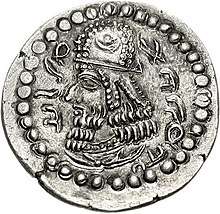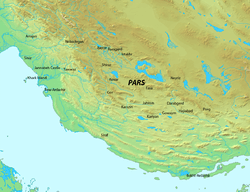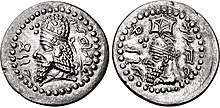Pabag
Papag (Middle Persian: 𐭯𐭠𐭯𐭪𐭩, Pāpak/Pābag; New Persian: بابک Bābak), was an Iranian prince, who ruled the Istakhr, the capital of Pars, from 205/6 till his death sometime between 207–10. He was the father (or stepfather) of Ardashir I, the founder of the Sasanian Empire. He was succeeded by his eldest son Shapur.
| Pabag 𐭯𐭠𐭯𐭪𐭩 | |
|---|---|
| Shah | |
 A coin with the portrait of Pabag, minted by Ardashir I | |
| King of Istakhr | |
| Reign | 205/6 – 207–10 |
| Predecessor | Gochihr |
| Successor | Shapur |
| Died | 207–210 Istakhr, Pars, Iran |
| Issue | Shapur Ardashir Denag |
| Religion | Zoroastrianism |
Background and state of Pars
Pars (also known as Persis), a region in the southwestern Iranian plateau, was the homeland of a southwestern branch of the Iranian peoples, the Persians.[1] It also was also the birthplace of the first Iranian Empire, the Achaemenids.[1] The region served as the center of the empire until its conquest by the Macedonian king Alexander the Great (r. 336–323 BC).[1] Since the end of the 3rd or the beginning of the 2nd century BCE, Pars was ruled by local dynasts subject to the Hellenistic Seleucid Empire.[2] These dynasts held the ancient Persian title of frataraka ("leader, governor, forerunner"), which is also attested in the Achaemenid-era.[3] Later under the frataraka Wadfradad II (fl. 138 BC) was made a vassal of the Iranian Parthian (Arsacid) Empire.[2] The frataraka were shortly afterwards replaced by the Kings of Persis, most likely at the accession of the Arsacid monarch Phraates II (r. 132–127 BC).[4] Unlike the fratarakas, the Kings of Persis used the title of shah ("king"), and laid foundations to a new dynasty, which may be labelled the Darayanids.[4]
Origins
New Persian and Arabic texts

There are various different sources regarding the relationship between Pabag, Sasan, and the first Sasanian monarch Ardashir I (r. 224–242).[5] According to the Shahnameh ("The Book of Kings") by the medieval Persian poet Ferdowsi (d. 1020), Sasan was a descendant of the mythological Kayanian rulers Dara II, Dara I, Kay Bahman, Esfandiyar and Vishtaspa.[5] The claim of Sasan belonging to the Kayanian family was designed in order to justify that Ardashir was descended from the ancient Kayanian kings, who reflected memories of the Achaemenids.[5]
Dara II, the last Kayanian king to rule before Alexander, is partly based on the last Achaemenid King of Kings, Darius III (r. 336–330 BC), whose empire was indeed conquered by Alexander's forces.[5] A son of Dara II, named Sasan (called "the elder") fled to India and lived there in exile until his death.[5] He was survived by a son who was likewise named Sasan (called "the younger"), "which continued in the family for four generations".[5] A descendant of the family, likewise named Sasan, worked for Pabag, who was a local ruler in Pars.[5] Pabag's daughter married Sasan, and bore him a son named Ardashir.[5][6] Following this, Sasan is no longer mentioned.[5] The Shahnameh thus indicates that the ancestors of Sasan resided in India following Alexander's conquests.[5] This report has been used by scholars to point out Sasan's Indo-Parthian connection.[5]
According to the medieval Iranian historian al-Tabari (d. 923), Pabag was the son of Sasan and a princess named Rambihisht, who was from the Bazrangid family, a dynasty of petty rulers in Pars.[7][6] He presents Pabag as the father of Ardashir.[7] Like Ferdowsi in his Shahnameh, al-Tabari also describes Sasan as a foreigner in Pars, however, unlike him, he does not mention Sasan's place of origins.[7]
Middle Persian texts
The Middle Persian text Kar-Namag i Ardashir i Pabagan ("Book of the Deeds of Ardashir, son of Pabag"), says the following regarding the ancestry of Ardashir: ardaxšīr ī kay ī pābāgān ī az tohmag ī sāsān ud nāf ī dārāy šāh ("Ardashir, the Kayanian, son of Pabag from the parentage of Sasan and from the lineage of King Dara").[5] Another Middle Persian text, the Bundahishn, however, gives the genealogy of Ardashir as following: Artaxšahr ī Pābagān kē-š mād duxt ī Sāsān ī Weh-āfrīd ("Ardashir son of Pabag whose mother (was) the daughter of Sasan son of Weh-afrid").[5] This demonstrates the inconsistencies between Middle Persian texts regarding the origins of the Sasanian dynasty.[5] Both sources regard Pabag as the father of Ardashir, whilst Sasan is presented as the latters grandfather or ancestor.[5]
Roman and Armenian texts
In Roman and Armenian sources, a different account appears. According to the Roman historians Agathias and George Syncellus, Sasan was the biological father of Ardashir, whilst Pabag was his stepfather.[7] The Armenian writers Movses Khorenatsi and Agathangelos likewise call Sasan the father of Ardashir. However, they do not make any mention of Pabag.[7] A Greek variant of Agathangelos' work, calls Ardashir "son of Sasanus, which is the origin of the Sasanian name of the Persian kings descended from him".[7]
Sasanian inscriptions and coinage
Ardashir, on his coin engravings and inscription on Naqsh-e Rostam claims to be the son of "divine Pabag, the king".[7] His son and successor, Shapur I (r. 240–270), on his inscriptions at Naqsh-e Rajab, calls himself as a son of Ardashir I and grandson of Pabag.[7]
Conclusions in modern scholarship
Biography
Pabag ruled a small principality in the area of Khir, south of the Bakhtegan Lake.[8] He was a vassal of Gochihr, the Bazrangid king of the Persian capital of Istakhr, who was in turn a vassal of the Arsacid King of Kings.[9][10] With the permission of Gochihr, Pabag sent Ardashir to the fortress of Darabgerd to serve under its commander, Tiri.[11] Pabag reportedly served as a priest of the fire-temple of Anahita in Istakhr, which served as a rallying point of the local Persian soldiers, who worshipped the Iranian goddess.[10] The Arsacid Empire, then ruled by Vologases V (r. 191–208), was at this time in decline, due to wars with the Romans, civil wars and regional revolts.[12] The Roman emperor Septimius Severus (r. 193–211) had invaded the Arsacid domains in 196, and two years later did the same, this time sacking the Arsacid capital of Ctesiphon.[12] At the same time, revolts occurred in Media and Pars.[12]

The Iranologist Touraj Daryaee argues that the reign of Vologases V was "the turning point in Arsacid history, in that the dynasty lost much of its prestige."[12] The kings of Persis were now unable to depend on their weakened Arsacid overlords.[12] Indeed, in 205/6, Pabag rebelled and overthrew Gochihr, taking Istakhr for himself.[10][12] According to al-Tabari, it was at the urging of Ardashir that Pabag rebelled. However, Daryaee considers this statement unlikely, and states that it was in reality Shapur that helped Pabag to capture Istakhr, as demonstrated by the latter's coinage which has portraits of both them.[8]
There he appointed his eldest son Shapur as his heir.[12] This was much to the dislike of Ardashir, who had become the commander of Darabgerd after the death of Tiri.[12][11] Ardashir in an act of defiance, left for Ardashir-Khwarrah, where he fortified himself, preparing to attack his brother Shapur after Pabag's death.[12][lower-alpha 1] Pabag died a natural death sometime between 207–10 and was succeeded by Shapur.[14] After his death, both Ardashir and Shapur started minted coins with the title of "king" and the portrait of Pabag.[15] The observe of Shapur's coins had the inscription "(His) Majesty, king Shapur" and the reverse had "son of (His) Majesty, king Pabag".[16] Shapur's reign, however, proved short; he died under obscure conditions in 211/2.[16][12] Ardashir thus succeeded Shapur, and went on to conquer the rest of Iran, establishing the Sasanian Empire in 224.[16][11] Pabag was also survived by a daughter named Denag, who married Ardashir.[17]
Notes
- Physical evidence demonstrates that it was not from Darabgerd, as stated by al-Tabari, that Ardashir started expanding his domains, but from Ardashir-Khwarrah.[13]
References
- Wiesehöfer 2000a, p. 195.
- Wiesehöfer 2009.
- Wiesehöfer 2000b, p. 195.
- Shayegan 2011, p. 178.
- Olbrycht 2016, p. 26.
- Frye 1988, pp. 298–299.
- Olbrycht 2016, p. 27.
- Daryaee 2010, p. 245.
- Kia 2016, p. 224.
- Daryaee 2012, p. 187.
- Wiesehöfer 1986, pp. 371–376.
- Daryaee 2010, p. 249.
- Daryaee 2010, p. 247.
- Frye 1988, pp. 298–299; Daryaee 2010, p. 252; Curtis & Stewart 2008, p. 34
- Daryaee 2010, p. 250.
- Daryaee 2014, p. 4.
- Gignoux 1994, p. 282.
Sources
- Curtis, Vesta Sarkhosh; Stewart, Sarah (2008). The Sasanian Era. I.B.Tauris. pp. 1–200. ISBN 9780857719720.CS1 maint: ref=harv (link)
- Daryaee, Touraj (2014). Sasanian Persia: The Rise and Fall of an Empire. I.B.Tauris. pp. 1–240. ISBN 978-0857716668.CS1 maint: ref=harv (link)
- Daryaee, Touraj (2012). "The Sasanian Empire (224–651)". In Daryaee, Touraj (ed.). The Oxford Handbook of Iranian History. Oxford University Press. ISBN 978-0199732159.CS1 maint: ref=harv (link)
- Daryaee, Touraj (2010). "Ardashir and the Sasanians' Rise to Power". University of California: 236–255. Cite journal requires
|journal=(help)CS1 maint: ref=harv (link) - Frye, R. N. (1988). "Bābak (1)". Encyclopaedia Iranica, Vol. III, Fasc. 3. pp. 298–299.CS1 maint: ref=harv (link)
- Gignoux, Philippe (1994). "Dēnag". Encyclopaedia Iranica, Vol. VII, Fasc. 3. p. 282.CS1 maint: ref=harv (link)
- Kia, Mehrdad (2016). The Persian Empire: A Historical Encyclopedia. ABC-CLIO. ISBN 978-1610693912.CS1 maint: ref=harv (link) (2 volumes)
- McDonough, Scott (2013). "Military and Society in Sasanian Iran". In Campbell, Brian; Tritle, Lawrence A. (eds.). The Oxford Handbook of Warfare in the Classical World. Oxford University Press. pp. 1–783. ISBN 9780195304657.CS1 maint: ref=harv (link)
- Olbrycht, Marek Jan (2016). "Dynastic Connections in the Arsacid Empire and the Origins of the House of Sāsān". In Curtis, Vesta Sarkhosh; Pendleton, Elizabeth J.; Alram, Michael; Daryaee, Touraj (eds.). The Parthian and Early Sasanian Empires: Adaptation and Expansion. Oxbow Books. ISBN 9781785702082.CS1 maint: ref=harv (link)
- Shayegan, M. Rahim (2011). Arsacids and Sasanians: Political Ideology in Post-Hellenistic and Late Antique Persia. Cambridge University Press. pp. 1–539. ISBN 9780521766418.CS1 maint: ref=harv (link)
- Rezakhani, Khodadad (2017). "East Iran in Late Antiquity". ReOrienting the Sasanians: East Iran in Late Antiquity. Edinburgh University Press. pp. 1–256. ISBN 9781474400305. JSTOR 10.3366/j.ctt1g04zr8.CS1 maint: ref=harv (link) (registration required)
- Wiesehöfer, Joseph (1986). "Ardašīr I i. History". Encyclopaedia Iranica, Vol. II, Fasc. 4. pp. 371–376.CS1 maint: ref=harv (link)
- Wiesehöfer, Josef (2000b). "Frataraka". Encyclopaedia Iranica, Vol. X, Fasc. 2. p. 195.CS1 maint: ref=harv (link)
- Wiesehöfer, Joseph (2000a). "Fārs ii. History in the Pre-Islamic Period". Encyclopaedia Iranica.CS1 maint: ref=harv (link)
- Wiesehöfer, Josef (2009). "Persis, Kings of". Encyclopaedia Iranica.CS1 maint: ref=harv (link)
| Preceded by Gochihr |
King of Istakhr 205/6 – 207–10 |
Succeeded by Shapur |